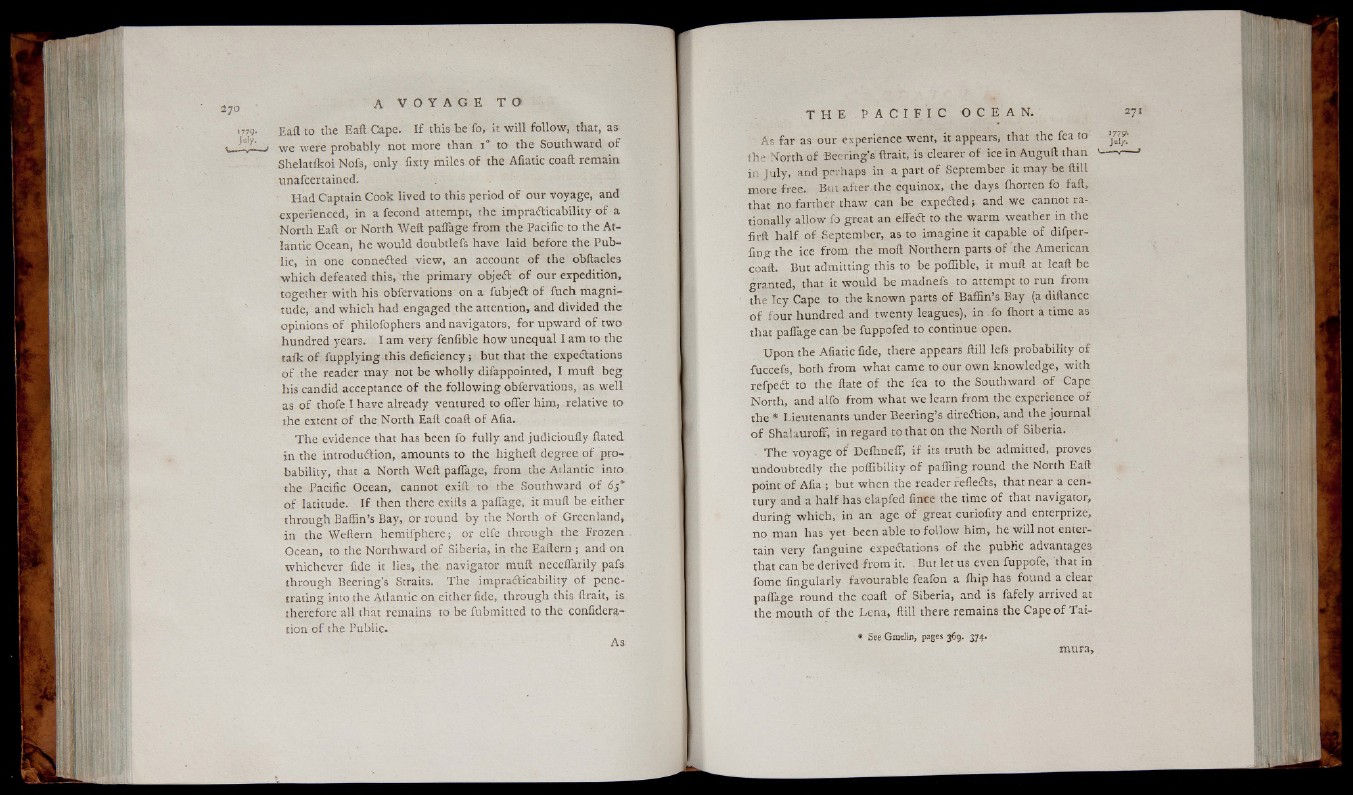
Eaft to the Eaft Cape. I f this he fo, it w ill follow, that, as
w e were probably not more than i° to the Southward o f
Shelatlkoi Nofs, only fixty miles o f the Afiatic coaft remain
unafcertained.
Had Captain Cook lived to this period o f our voyage, and
experienced, in a fecond attempt, the impracticability o f a
North Eaft or North Weft paffage from the Pacific to the Atlantic
Ocean, he wou ld doubtlefs have laid before the Public,
in one connedted view , an account o f the obftacles
w h ich defeated this, the primary objedt o f our expedition,
together with his obfervations on a fubjedt o f fuch m a gn itude,
and w h ich had engaged the attention, and divided the
opinions o f philofophers and navigators, fo r upward o f two
hundred years. I am ve ry fenfible how unequal I am to the
talk o f fupplying this deficiency; but that the expectations
o f the reader may not be w h o lly difappointed, I muft be g
his candid acceptance o f the fo llow in g obfervations, as w e ll
as o f th o fe lh a v e already ventured to offer him, relative to
the extent o f the North Eaft coaft o f Afia.
T h e evidence that has been fo fu lly and judicioufly ftated
in the introduction, amounts to the higheft degree o f probability,
that a North Weft paflage, from the Atlantic into
the Pacific Ocean, cannot exift to the Southward o f 65®
o f latitude. I f then there exifts a paflage, it muft be either
through Baffin’s Bay, or round by the North o f Greenland,
in the Weftern hem ifph ere ; or elfe through the Frozen
Ocean, to the Northward o f Siberia, in the Eaftern ; and on
whichever fide it lies, the navigator muft neceflarily pafs
throu gh Beering’s Straits. T h e impracticability o f penetrating
into the Atlantic on either fide, through this ftrait, is
therefore all that remains to be fubmitted to the confidera-
tion o f the Public.
As
As far as our experience went, it appears, that the fea to
the North o f Beering’s ftrait, is clearer o f ice in Auguft than '-----
in July, and perhaps in a part o f September it may be ftill
more free. But after the equinox, the days ihorten fo faft,
that no farther thaw can be expedted; and we cannot rationally
allow fo great an effect to the warm weather in the
fir ft h a lf o f September, as to imagine it capable o f difper-
fing the ice from the mod Northern parts o f 'the American
coaft. But admitting this to be poifible, it muft at leaft be
granted, that it would be madnefs to attempt to run from
the Icy Cape to the known parts o f Baffin’s Bay (a diftance
o f four hundred and twenty leagues), in To ihort a time as
that paflage can be fuppofed to continue open.
Upon the Afiatic fide, there appears ftill lefs probability o f
fuccefs, both from what came to our own knowledge, with
refpedt to the ftate o f the fea to the Southward o f Cape
North, and alfo from what we learn from the. experience o f
the * Lieutenants under Beering’s diredtion, and the journal
o f Shalauroff, in regard to that on the North o f Siberia.
T h e voyage o f Deihneff, i f its truth be admitted, proves
undoubtedly the poffibility o f p allin g round the North Eaft
point o f Afia ; but when the reader refledts, that near a century
and a h a lf has elapfed fince the time o f that navigator,
during which, in an age o f great curiofity and enterprize,
no man has yet been able to fo llow him, he w ill not entertain
very fanguine expedfations o f the public advantages
can Ee derived from it. But let us even fuppofe, that in
fome Angularly favourable feafon a ihip has found a clear
paflage round the coaft o f Siberia, and is fafely arrived at
the mouth o f the Lena, ftill there remains the Cape o f Tai-
* See Gmelin, pages 369. 374.
mu ra,